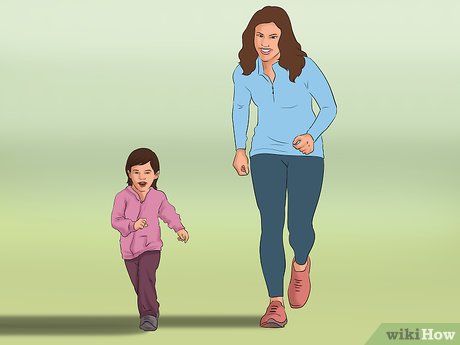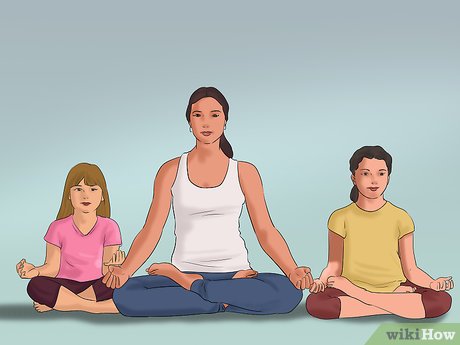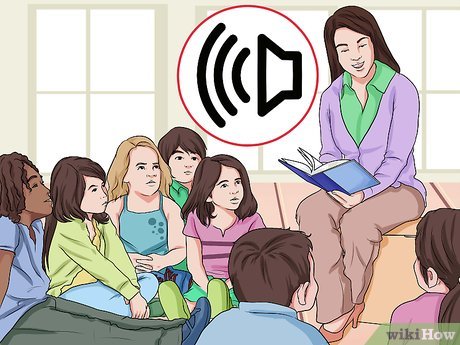Everyone realizes that skyrocketing obesity rates, not just among adults but also children, present a global health hazard. Efforts to reduce obesity among children tend to focus on healthier eating and more exercise, but cutting down on sedentary behavior (SB), like “screen time” or simply sitting on the bus or in school, needs to be a point of emphasis as well.X Because children spend a significant amount of time in school, making changes there to reduce sedentary time can offer health benefits on its own, as well as help to change overall behavior patterns.
StepsPart 1Part 1 of 2:Adjusting the School Environment
1Break up sedentary time. Most children are by nature active beings, but being required to sit for long stretches (such as at a school desk) can help to ingrain more sedentary behavior (SB) patterns. There has to be some amount of sedentary time in order for learning to take place, but interspersing sit-down time with even brief activities is an important step toward altering SB patterns.XTrustworthy SourcePubMed CentralJournal archive from the U.S. National Institutes of HealthGo to sourceBrief activities — or “energizers” — interspersed throughout the day not only help reduce the overall amount of sedentary time per day, they also can benefit health, focus, and academic achievement. For instance, students who take a 10-minute walk before a test have been shown to display better focus, increased relaxation, and thus better scores.Adjust your class schedule, if necessary. Aim to alternate between sedentary activities and activities that encourage movement. For example, begin with a math lesson, schedule in free play, teach a reading lesson, then engage in an activity that encourages gross motor skills.Between different lessons, you could have a “brain break,” where you and your students could dance, learn a yoga pose, or practice mindfulness.XExpert SourceCourtney CoprivizaElementary School TeacherExpert Interview. 18 June 2021.
2Create “active” lessons and assignments. For teachers, reducing sedentary time in school often boils down to basic alterations like designing class activities that require students to stand instead of sit, or move around instead of remaining still. “Active” lessons and homework require students to do more than watch a video, work on a computer, or read a textbook; they require them to get up and get moving.XTrustworthy SourcePubMed CentralJournal archive from the U.S. National Institutes of HealthGo to sourceConsider, for instance, the difference between learning how paper is made by watching a video as opposed to getting your hands into some mushy wood pulp. The first option reinforces SB patterns like staring at a TV or other screen device, while the second promotes active, hands-on engagement. Beyond the possible health benefits, many children will gain more from more active forms of learning anyway.Schedule group projects that incorporate movement as well. When planning for a certain unit, aim to find activities that will keep your students active. For instance, have your students measure their body parts during an anatomy lesson or practice multiplication using jumping jacks.Try setting up your classroom with different rotation groups. Encourage students to spend time at each station, where they’ll work on an independent worksheet, play a partner game, or do some other kind of activity. After 5 minutes, rotate your students to the next station.XExpert SourceCourtney CoprivizaElementary School TeacherExpert Interview. 18 June 2021.
3Stand instead of sit. Some workplaces have begun to transition from traditional desks to taller, chair-free standing desks — or even the so-called “treadmill desk.” Should this concept take off widely in schools, it would no doubt significantly reduce daily sitting time. It may seem like a small difference, but the simple act of standing instead of sitting can offer several health benefits.XThe cost involved in switching to standing desks is not inconsequential, of course, but teachers can work to increase standing time in other ways as well. Recurring or random times when the students must stand at their desks instead of sitting can be incorporated into the daily routine, for instance.You can encourage movement in your classroom by having an empty, open area that is accessible to all students. Move chairs and desks away from this area so the children can use the space to stay active.XMoving around is especially important for younger elementary-aged students, as they can’t stay seated for long periods of time.XExpert SourceCourtney CoprivizaElementary School TeacherExpert Interview. 18 June 2021.
4Give kids options. Kids, like adults, tend to respond better to changes when they feel like they have some measure of choice or control over the process. Rather than simply dictating a set list of changes to reduce sedentary time, it is preferable to offer a range of alternate activity options from which the kids can choose. If they feel like active agents of change at school, they may be more likely to carry such positive changes home as well.XFor instance, teachers can offer a set of “daily physical activity” (DPA) bins from which students can choose from a variety of games and activities. Or, a greater emphasis can be placed upon offering a range of intramural activities, including sports but also activities like dancing, yoga, etc., that emphasize “fundamental movement skills.”
5Offer incentives and rewards. It is important to let kids know that decreasing sedentary behavior can help improve overall health, reduce obesity, and enhance academic performance. However, such concepts can be a bit abstract, especially in comparison to some old-fashioned, age-appropriate rewards. For smaller kids, simple incentives like stickers or bracelets can spur enthusiasm for making changes. For older kids, providing pedometers or accelerometers can act as a combined reward and self-monitoring device.One of the numerous programs established in schools to reduce SB emphasizes replacing sedentary “screen time” with physical activities that focus on mastering six core skills: running, throwing, dodging, striking, jumping, and kicking. In this case, the reward itself (achieving “mastery”) reinforces the desired behavioral change.XPart 2Part 2 of 2:Changing Behaviors
1Join the larger battle against obesity. School-focused programs to improve healthy eating, increase daily exercise, and reduce sedentary behavior (especially “screen time”) often exist separately, even though they are by and large working toward the same goal—reducing childhood obesity rates. Combining these efforts into a coordinated, integrated program can add consistency and focus to the overall effort, and thereby increase the likelihood of support from kids and families.XCombining efforts does not mean minimizing the importance of addressing sedentary behavior (SB), however. While eating healthier and exercising more can seem more important on the surface, reducing the amount of sedentary time is important on its own and serves as a gateway to making those changes as well. Less sedentary time naturally leads to more exercise and usually decreases unhealthy eating activities like mindless snacking on junk foods.
2Recognize the stakes. Fortunately for school administrators and other interested parties seeking to change SB among students, ample evidence exists regarding the negative impacts of excessive sedentary time and the benefits of decreasing it. Kids and—perhaps more importantly, parents—may be more likely to respond positively when presented with clear evidence of the value of reducing sedentary time.XRepeated scientific studies have shown that increased sedentary time decreases fitness, metabolic rate, self-esteem, and academic performance, and increases hunger stimulus, obesity rates, and aggressive behavior. In turn, decreased sedentary time (which, for instance in Canada, is estimated to entail 62% of the waking hours for an average child) has the opposite effects.Make an effort to communicate these facts, and the school’s progress toward the goals for active times, on a regular basis.
3Integrate programs regarding SB throughout the curriculum. While programs to reduce sedentary time seem like natural fits for physical education classes and recess periods, for instance, they are more effective when they are incorporated into the entire school day. From standing up during math lessons, to doing hands-on activities during history class, to scheduling activity breaks before tests, changing SB needs to be seen as a “total team effort.”XOne of the early efforts at reducing SB in schools, known as the “Planet Health” program, was integrated throughout the curriculum in its test sites, and subsequent programs (such as “Switch-Play” and “Active for Life”) have tended to follow suit. Researchers have understood that changing behaviors as ingrained as sitting in on a bus, at a desk, or in front of a TV or computer screen cannot be effectively changed piecemeal, but only as part of a holistic approach that addresses core behavioral patterns.You can create an anti-SB committee with representatives for administrators, educators, parents, and students. Hold regular meetings and work toward reducing SB time during the school day.
4Get families and the community involved. Like most school-based programs (and education in general), parental involvement is critical to the success of programs intended to address SB. To truly succeed, programs must involve “intense behavioral interventions” to address the core behaviors that tend to increase sedentary time. Behavioral changes made in school can carry over into the home and community, but only with the support of those outside the school walls.XXParents need to be informed and involved in every step of the process when SB programs are initiated. Explain why students are standing up more, taking activity breaks, and being advised to reduce “screen time.” Provide activities and alternatives for the home setting, and opportunities for parents to get actively involved in the program both in and out of school. Make it clear that changing SB is beneficial for everyone, kids and adults alike.








